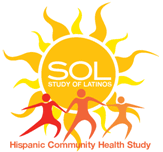| Title | Gut microbiome composition in the Hispanic Community Health Study/Study of Latinos is shaped by geographic relocation, environmental factors, and obesity. |
| Publication Type | Publication |
| Year | 2019 |
| Authors | Kaplan RC, Wang Z, Usyk M, Sotres-Alvarez D, Daviglus ML, Schneiderman N, Talavera GA, Gellman MD, Thyagarajan B, Moon J-Y, Vázquez-Baeza Y, McDonald D, Williams-Nguyen JS, Wu MC, North KE, Shaffer J, Sollecito CC, Qi Q, Isasi CR, Wang T, Knight R, Burk RD |
| Journal | Genome Biol |
| Volume | 20 |
| Issue | 1 |
| Pagination | 219 |
| Date Published | 2019 Nov 01 |
| ISSN | 1474-760X |
| Keywords | Acculturation, Adult, Aged, Cohort Studies, diet, Emigration and Immigration, Female, Gastrointestinal Microbiome, Hispanic or Latino, Humans, Latin America, Male, Middle Aged, Obesity |
| Abstract | BACKGROUND: Hispanics living in the USA may have unrecognized potential birthplace and lifestyle influences on the gut microbiome. We report a cross-sectional analysis of 1674 participants from four centers of the Hispanic Community Health Study/Study of Latinos (HCHS/SOL), aged 18 to 74 years old at recruitment.RESULTS: Amplicon sequencing of 16S rRNA gene V4 and fungal ITS1 fragments from self-collected stool samples indicate that the host microbiome is determined by sociodemographic and migration-related variables. Those who relocate from Latin America to the USA at an early age have reductions in Prevotella to Bacteroides ratios that persist across the life course. Shannon index of alpha diversity in fungi and bacteria is low in those who relocate to the USA in early life. In contrast, those who relocate to the USA during adulthood, over 45 years old, have high bacterial and fungal diversity and high Prevotella to Bacteroides ratios, compared to USA-born and childhood arrivals. Low bacterial diversity is associated in turn with obesity. Contrasting with prior studies, our study of the Latino population shows increasing Prevotella to Bacteroides ratio with greater obesity. Taxa within Acidaminococcus, Megasphaera, Ruminococcaceae, Coriobacteriaceae, Clostridiales, Christensenellaceae, YS2 (Cyanobacteria), and Victivallaceae are significantly associated with both obesity and earlier exposure to the USA, while Oscillospira and Anaerotruncus show paradoxical associations with both obesity and late-life introduction to the USA.CONCLUSIONS: Our analysis of the gut microbiome of Latinos demonstrates unique features that might be responsible for health disparities affecting Hispanics living in the USA. |
| DOI | 10.1186/s13059-019-1831-z |
| Alternate Journal | Genome Biol |
| PubMed ID | 31672155 |
| PubMed Central ID | PMC6824043 |
| Grant List | R01 GM129512 / GM / NIGMS NIH HHS / United States HHSN268201300004I / N01-HC-65234 / HL / NHLBI NIH HHS / United States HHSN268201300004C / HL / NHLBI NIH HHS / United States HHSN268201300001C / HL / NHLBI NIH HHS / United States R01 HG009974 / HG / NHGRI NIH HHS / United States N01HC65234 / HL / NHLBI NIH HHS / United States P30 DK111022 / DK / NIDDK NIH HHS / United States 1R01MD011389-01 / HL / NHLBI NIH HHS / United States HHSN268201300003C / HG / NHGRI NIH HHS / United States HHSN268201300003I / N01-HC-65236 / HL / NHLBI NIH HHS / United States HHSN268201300002I / N01-HC-65235 / HL / NHLBI NIH HHS / United States R01 MD011389 / MD / NIMHD NIH HHS / United States R01 DK119268 / DK / NIDDK NIH HHS / United States HHSN268201300001I / N01-HC-65233 / HL / NHLBI NIH HHS / United States |
Gut microbiome composition in the Hispanic Community Health Study/Study of Latinos is shaped by geographic relocation, environmental factors, and obesity.
MS#:
0715
ECI:
Manuscript Affiliation:
Field Center: Bronx (Einstein College of Medicine)
Manuscript Status:
Published
